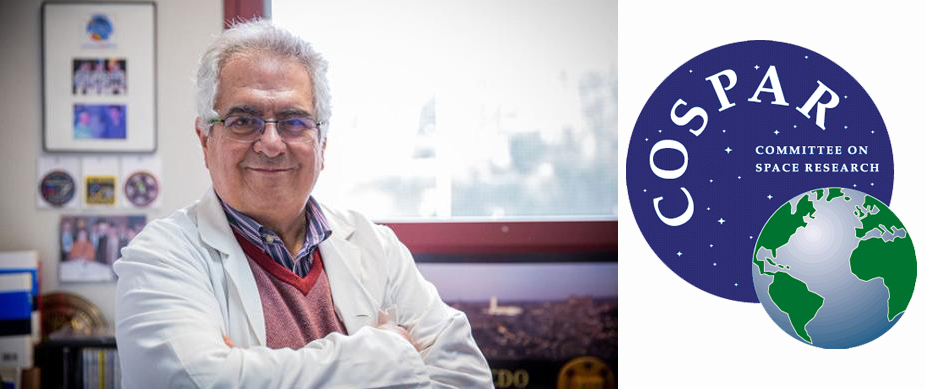
The organization COSPAR (Commitee on Space Research) has awarded Dr. F. Javier Medina, head of the laboratory "Nucleolus, Cell Proliferation and Microgravity in Plants" of the Margarita Salas Center for Biological Research, with the "International Cooperation Medal" "for his outstanding contribution to the development of international cooperation in the field of space research”.
Dr. Medina shares the award with Prof. John Z. Kiss, from the University of North Carolina at Greensboro (USA), with whom he co-directed the series of experiments called "Seedling Growth", recently completed on the International Space Station. The award will be presented at the next COSPAR organization Congress, to be held in Sydney, Australia, in January 2021, after being postponed due to the SARS-CoV-2 pandemic. As a curious fact, the award includes the nomination of an asteroid with the name of the awardee.
COSPAR is the world's largest organization dedicated to space research in all its aspects, organized into up to eight thematic areas (Scientific Commissions), from Astrophysics to Space Biology. It was created in 1958, at the dawn of space adventure, by the International Council of Science, to join this body related to the UN and UNESCO and to coordinate and stimulate the activities of national government agencies and international scientific unions related to space research.
The "Seedling Growth" project has been the successful result of an ambitious international cooperation initiative. Arising from the joint scientific proposal of its two co-PIs, seeking the synergy of two different, but complementary, scientific objectives, it gave rise to a NASA-ESA agreement for its execution. The experiments have been carried out in a European incubator, using American culture chambers, modified by a Spanish company to allow the chemical fixation of the samples in them, using a newly designed device [1]. In addition, the European scientific team led by Dr. Medina has included two French laboratories.
The results of the project contribute to making possible the cultivation of plants for human life support, essential for future manned space exploration missions, including possible human habitats on the Moon and Mars. Light stimuli have been shown to favorably modify plant growth in space, in the absence of gravity, and red light is capable of reversing early development alterations caused by microgravity [2, 3]. In the latest articles, published in 2019, the response of plants in terms of changes in gene expression when exposed to blue light photostimulation is detailed, both in microgravity conditions [4], and in reduced gravity conditions such as those existing on the surface of the Moon and Mars [5]. The molecular mechanisms that control these responses will be revealed in the coming months with the study of transgenic plants and mutants that were part of the samples sent to space. These works have been complemented with experiments in terrestrial facilities of altered gravity simulation, also using alternative experimental models, such as cell cultures [6-9]. The transcriptomic results have been incorporated into the NASA-GeneLab project for the most efficient use of omic data from space experiments. ESA has recently recognized this effort by funding a European Topical Team led by Dr. Raúl Herranz, a member of the group.

References:
1. Manzano A, Creus E, Tomás A, Valbuena MA, Villacampa A, Ciska M, Edelmann RE, Kiss JZ, Medina FJ, Herranz R: The FixBox: New hardware to provide on-orbit fixation capabilities to the EMCS on the ISS Microgravity Science and Technology 2020, Submitted.
2. Vandenbrink JP, Herranz R, Medina FJ, Edelmann RE, Kiss JZ: A novel blue-light phototropic response is revealed in roots of Arabidopsis thaliana in microgravity. Planta 2016, 244(6):1201-1215.
3. Valbuena MA, Manzano A, Vandenbrink JP, Pereda-Loth V, Carnero-Diaz E, Edelmann RE, Kiss JZ, Herranz R, Medina FJ: The combined effects of real or simulated microgravity and red-light photoactivation on plant root meristematic cells. Planta 2018, 248(3):691-704.
4. Vandenbrink JP, Herranz R, Poehlman WL, Alex Feltus F, Villacampa A, Ciska M, Medina FJ, Kiss JZ: RNA-seq analyses of Arabidopsis thaliana seedlings after exposure to blue-light phototropic stimuli in microgravity. Am J Bot 2019, 106(11):1466-1476.
5. Herranz R, Vandenbrink JP, Villacampa A, Manzano A, Poehlman WL, Feltus FA, Kiss JZ, Medina FJ: RNAseq Analysis of the Response of Arabidopsis thaliana to Fractional Gravity Under Blue-Light Stimulation During Spaceflight. Front Plant Sci 2019, 10(1529).
6. Kamal KY, Herranz R, van Loon JJWA, Medina FJ: Cell cycle acceleration and changes in essential nuclear functions induced by simulated microgravity in a synchronized Arabidopsis cell culture. Plant, Cell & Environment 2019, 42(2):480-494.
7. Kamal KY, van Loon JJWA, Medina FJ, Herranz R: Differential transcriptional profile through cell cycle progression in Arabidopsis cultures under simulated microgravity. Genomics 2019, 111(6):1956-1965.
8. Manzano A, Herranz R, den Toom LA, te Slaa S, Borst G, Visser M, Medina FJ, van Loon JJWA: Novel, Moon and Mars, partial gravity simulation paradigms and their effects on the balance between cell growth and cell proliferation during early plant development. npj Microgravity 2018, 4(1):9.
9. Kamal KY, Herranz R, van Loon JJWA, Medina FJ: Simulated microgravity, Mars gravity, and 2g hypergravity affect cell cycle regulation, ribosome biogenesis, and epigenetics in Arabidopsis cell cultures. Scientific Reports 2018, 8(1):6424.

